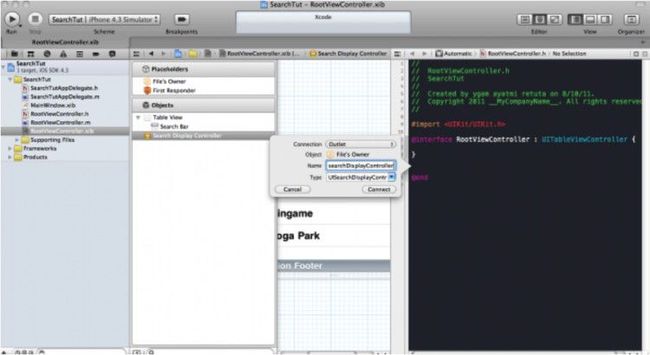UISearchDisplayController 的使用
今天,我会演示如何在iOS中实现本地搜索。代码是在苹果官方教程的基础上修改而来的。
新建Navigation-based Project。打开.xib文件,拖一个Search Bar and Search DisplayController 对象到Table View对象上方,如下图所示,选中File’s Owner ,打开Connections面板:
现在我们来创建Search Bar和SearchDisplay Controller的出口。打开Assistant Editor,按住ctrl键,将SearchDisplay Controller拖到ViewController 的头文件中。创建一个名为searchDisplayController的出口,然后点Connect。

同样的方法为Search Bar创建连接。现在ViewController的头文件看起来像这样:
| #import <UIKit/UIKit.h> @interface RootViewController : UITableViewController { UISearchDisplayController *searchDisplayController; UISearchDisplayController *searchBar; NSArray *allItems; NSArray *searchResults; } @property (nonatomic, retain) IBOutlet UISearchDisplayController *searchDisplayController; @property (nonatomic, retain) IBOutlet UISearchDisplayController *searchBar; @property (nonatomic, copy) NSArray *allItems; @property (nonatomic, copy) NSArray *searchResults; @end |
你可能注意到,我初始化了两个NSArray。一个用于作为数据源,一个用于保存查找结果。在本文中,我使用字符串数组作为数据源。继续编辑.m文件前,别忘了synthesize相关属性:
| @synthesize searchDisplayController; @synthesize searchBar; @synthesize allItems; @synthesize searchResults; |
在viewDidLoad 方法中,我们构造了我们的字符串数组:
| - (void)viewDidLoad { [super viewDidLoad]; // [self.tableView reloadData]; self.tableView.scrollEnabled = YES; NSArray *items = [[NSArray alloc] initWithObjects: @"Code Geass", @"Asura Cryin'", @"Voltes V", @"Mazinger Z", @"Daimos", nil]; self.allItems = items; [items release]; [self.tableView reloadData]; } |
在Table View的返回TableView行数的方法中,我们先判断当前Table View是否是searchDisplayController的查找结果表格还是数据源本来的表格,然后返回对应的行数:
| - (NSInteger)tableView:(UITableView *)tableView numberOfRowsInSection:(NSInteger)section { NSInteger rows = 0; if ([tableView isEqual:self.searchDisplayController.searchResultsTableView]){ rows = [self.searchResults count]; }else{ rows = [self.allItems count]; } return rows; } |
在tableView:cellForRowAtIndexPath:方法里,我们需要做同样的事:
| // Customize the appearance of table view cells. - (UITableViewCell *)tableView:(UITableView *)tableView cellForRowAtIndexPath:(NSIndexPath *)indexPath { static NSString *CellIdentifier = @"Cell"; UITableViewCell *cell = [tableView dequeueReusableCellWithIdentifier:CellIdentifier]; if (cell == nil) { cell = [[[UITableViewCell alloc] initWithStyle:UITableViewCellStyleDefault reuseIdentifier:CellIdentifier] autorelease]; cell.accessoryType = UITableViewCellAccessoryDisclosureIndicator; } /* Configure the cell. */ if ([tableView isEqual:self.searchDisplayController.searchResultsTableView]){ cell.textLabel.text = [self.searchResults objectAtIndex:indexPath.row]; }else{ cell.textLabel.text = [self.allItems objectAtIndex:indexPath.row]; } return cell; } |
现在来实现当搜索文本改变时的回调函数。这个方法使用谓词进行比较,并讲匹配结果赋给searchResults数组:
| - (void)filterContentForSearchText:(NSString*)searchText scope:(NSString*)scope { NSPredicate *resultPredicate = [NSPredicate predicateWithFormat:@"SELF contains[cd] %@", searchText]; self.searchResults = [self.allItems filteredArrayUsingPredicate:resultPredicate]; } |
接下来是UISearchDisplayController的委托方法,负责响应搜索事件:
| #pragma mark - UISearchDisplayController delegate methods -(BOOL)searchDisplayController:(UISearchDisplayController *)controller shouldReloadTableForSearchString:(NSString *)searchString { [self filterContentForSearchText:searchString scope:[[self.searchDisplayController.searchBar scopeButtonTitles] objectAtIndex:[self.searchDisplayController.searchBar selectedScopeButtonIndex]]]; return YES; } - (BOOL)searchDisplayController:(UISearchDisplayController *)controller shouldReloadTableForSearchScope:(NSInteger)searchOption { [self filterContentForSearchText:[self.searchDisplayController.searchBar text] scope:[[self.searchDisplayController.searchBar scopeButtonTitles] objectAtIndex:searchOption]]; return YES; } |
运行工程,当你在搜索栏中点击及输入文本时,如下图所示:

